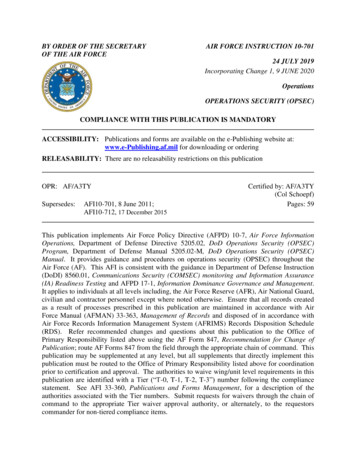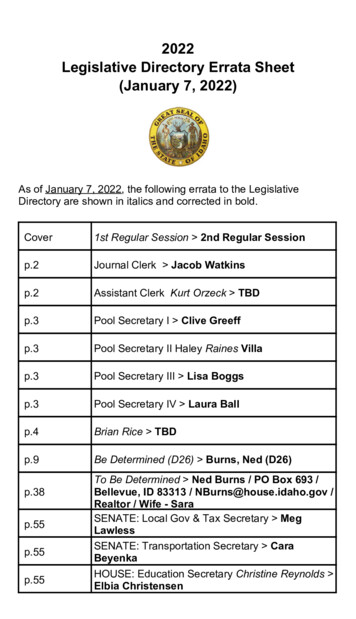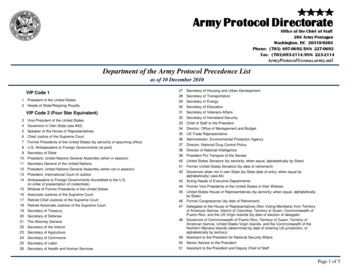
Transcription
BY ORDER OF THE SECRETARYOF THE AIR FORCEAIR FORCE INSTRUCTION 10-70124 JULY 2019Incorporating Change 1, 9 JUNE 2020OperationsOPERATIONS SECURITY (OPSEC)COMPLIANCE WITH THIS PUBLICATION IS MANDATORYACCESSIBILITY: Publications and forms are available on the e-Publishing website at:www.e-Publishing.af.mil for downloading or orderingRELEASABILITY: There are no releasability restrictions on this publicationOPR: AF/A3TYSupersedes:AFI10-701, 8 June 2011;AFI10-712, 17 December 2015Certified by: AF/A3TY(Col Schoepf)Pages: 59This publication implements Air Force Policy Directive (AFPD) 10-7, Air Force InformationOperations, Department of Defense Directive 5205.02, DoD Operations Security (OPSEC)Program, Department of Defense Manual 5205.02-M, DoD Operations Security (OPSEC)Manual. It provides guidance and procedures on operations security (OPSEC) throughout theAir Force (AF). This AFI is consistent with the guidance in Department of Defense Instruction(DoDI) 8560.01, Communications Security (COMSEC) monitoring and Information Assurance(IA) Readiness Testing and AFPD 17-1, Information Dominance Governance and Management.It applies to individuals at all levels including, the Air Force Reserve (AFR), Air National Guard,civilian and contractor personnel except where noted otherwise. Ensure that all records createdas a result of processes prescribed in this publication are maintained in accordance with AirForce Manual (AFMAN) 33-363, Management of Records and disposed of in accordance withAir Force Records Information Management System (AFRIMS) Records Disposition Schedule(RDS). Refer recommended changes and questions about this publication to the Office ofPrimary Responsibility listed above using the AF Form 847, Recommendation for Change ofPublication; route AF Forms 847 from the field through the appropriate chain of command. Thispublication may be supplemented at any level, but all supplements that directly implement thispublication must be routed to the Office of Primary Responsibility listed above for coordinationprior to certification and approval. The authorities to waive wing/unit level requirements in thispublication are identified with a Tier (“T-0, T-1, T-2, T-3”) number following the compliancestatement. See AFI 33-360, Publications and Forms Management, for a description of theauthorities associated with the Tier numbers. Submit requests for waivers through the chain ofcommand to the appropriate Tier waiver approval authority, or alternately, to the requestorscommander for non-tiered compliance items.
2AFI10-701 24 JULY 2019SUMMARY OF CHANGESThis interim change revises AFI 10-701 by (1) deleting OPSEC working group requirements inparagraph 2.18 and 2.19, (2) adding OPSEC working group requirements to the roles andresponsibilities of the commander/directors, OPSEC Program Manager and OPSEC SignatureManager in paragraphs 2.17, 2.20, 2.21 and 2.22, (3) adding OPSEC Signature Managementresponsibilities to paragraph 2.22, (4) revising mission-oriented training within paragraph 4.3,OPSEC program management assessments within paragraph 5.3.5 and Electronic SystemSecurity Assessments within paragraph 6.6 A margin bar ( ) indicates newly revised material.Chapter 1—OPERATIONS SECURITY (OPSEC) OVERVIEW1.1.6National Security Decision Directive 298, National Operations Security Programrequires each executive department and agency with a national security missionto have an OPSEC program. .6OPSEC is an information-related capability that preserves friendly essentialsecrecy by using a process to identify, control and protect critical informationand indicators. .6Essential secrecy is the condition achieved by denying critical information andindicators to adversaries. .6OPSEC, when closely integrated and synchronized with other informationrelated capabilities, security disciplines and all aspects of protected operations,preserves essential secrecy. .6OPSEC supports planning, preparation, execution and post execution phases ofall activities, operations and programs across the entire spectrum of militaryoperations. .6Commanders and directors are responsible for identifying and managingsignatures associated with Air Force activities, capabilities, operations, andprograms. .7OPSEC is a commander’s/director’s responsibility and is established, managedand implemented at all levels throughout the AF. .7Figure 1.1.Air Force Operations Security Organizational Structure. .71.8.OPSEC is everyone’s responsibility. .81.9.To enhance the effectiveness and understanding of OPSEC: .81.10.Ideally, the Air Force uses OPSEC countermeasures to protect its criticalinformation.8Air Force OPSEC SharePoint Sites. .81.2.1.3.1.4.1.5.1.6.1.7.1.11.
AFI10-701 24 JULY 20193Chapter 2—ROLES AND RESPONSIBILITIES92.1.Air Force Judge Advocate General (AF/JA).92.2.The Deputy Chief of Staff for Manpower, Personnel & Services (AF/A1). .92.3.The Deputy Chief of Staff for Intelligence, Surveillance and Reconnaissance(AF/A2).92.4.The Deputy Chief of Staff for Operations (AF/A3). .92.5.Deputy Chief of Staff, Logistics, Engineering and Force Protection (AF/A4). .102.6.Secretary of the Air Force Deputy Chief Information Officer (SAF/CN). .102.7.The Secretary of the Air Force, Office of Public Affairs (SAF/PA). .112.8.The Secretary of the Air Force for Acquisition, Technology & Logistics(SAF/AQ).112.9.The Administrative Assistant to the Secretary of the Air Force (SAF/AA). .112.10.The Secretary of the Air Force, Inspector General (SAF/IG). .112.11.The Office of the Secretary of the Air Force General Counsel (SAF/GC). .112.12.Secretary of the Air Force Chief Data Officer (SAF/CO). .122.13.Air Combat Command (ACC). .122.14.Air Force Materiel Command. .142.15.Air Education and Training Command (AETC). .142.16.Air Force Academy. .142.17.Commanders/Directors at all levels. .142.18.Commanders at MAJCOMs, DRUs and Air Force Forces (AFFOR). .152.19.Commanders/Directors at Field Operating Agencies (FOA), Wings and WingEquivalent Organizations (e.g., Centers, Laboratories .17Air Force OPSEC Program Manager is the appointed adviser to Air ForceLeadership regarding Air Force OPSEC. .182.21.OPSEC Program Managers at MAJCOMs, DRUs and AFFORs. .192.22.OPSEC Signature Managers at FOAs, Wings, and wing equivalent organizations’(e.g. Centers, Laboratories). .202.23.OPSEC Planners. .222.24.OPSEC Coordinators at all levels. .222.20.
4AFI10-701 24 JULY 20192.25.Responsible Contracting Office. .Chapter 3—OPSEC PROCESSGeneral. .243.2.Identify Critical Information: .243.3.Analyze Threats: .253.4.Analyze Vulnerabilities: .253.5.Assess Risk: .263.6.Apply Countermeasures: .273.7.Signature Management. .27284.1.General. .284.2.OPSEC Awareness Education: .284.3.Mission Oriented and Pre-Deployment OPSEC Awareness Education: .294.4.Air Force OPSEC Training. .294.1.Air Force OPSEC Training Requirements. .32Chapter 5—EVALUATING OPSECTable243.1.Chapter 4—OPSEC EDUCATION AND TRAININGTable23335.1.Overview. .335.1.OPSEC Reviews and Assessments. .335.2.OPSEC Reviews. .345.3.Assessments. .355.4.Air Force OPSEC Support Team. .39Chapter 6—ELECTRONIC SYSTEM SECURITY ASSESSMENT (ESSA)416.1.Overview. .416.2.Purpose. .416.3.Monitoring Authority. .416.4.ESSA Request Priorities. .426.5.Release of Monitoring Information. .426.6.ESSA Products. .446.7.Active Indicator Monitoring Products. .46
AFI10-701 24 JULY 20196.8.Other Products. .Chapter 7—OPSEC PLANNING546477.1.General. .477.2.Incorporating OPSEC into Operational Planning. .477.3.Incorporating OPSEC into Support Plans. .487.4.Incorporating OPSEC into Exercise Planning. .48Chapter 8—OPSEC REQUIREMENTS WITHIN ACQUISITIONS AND CONTRACTING508.1.Incorporating OPSEC into the Acquisitions and Contracting Process. .508.2.Organizational Responsibilities. .508.3.Document Reviews. .50Attachment 1—GLOSSARY OF REFERENCES AND SUPPORTING INFORMATION52
6AFI10-701 24 JULY 2019Chapter 1OPERATIONS SECURITY (OPSEC) OVERVIEW1.1. National Security Decision Directive 298,National Operations Security Programrequireseach executive department and agency with a national security mission to have an OPSECprogram. Likewise, DoDD 5205.02E, DoD Operations Security (OPSEC) Program, supportsthe national program and requires each Department of Defense (DoD) component to establishand maintain an OPSEC program.1.2. OPSEC is an information-related capability that preserves friendly essential secrecyby using a process to identify, control and protect critical information and indicators. Ifcritical information and indicators are disclosed, it could allow adversaries or potentialadversaries to identify and exploit friendly vulnerabilities leading to increased risk to missionfailure or the loss of life. The desired effect of OPSEC is to influence the adversary’s behaviorand actions by reducing the adversary’s ability to collect and exploit critical information andindicators about friendly activities.1.3. Essential secrecy is the condition achieved by denying critical information andindicators to adversaries. Adversaries in possession of critical information can hinder orprevent friendly mission accomplishment. Thus, essential secrecy is a prerequisite for effectiveoperations.1.4. OPSEC, when closely integrated and synchronized with other information-relatedcapabilities, security disciplines and all aspects of protected operations, preserves essentialsecrecy. OPSEC does this by systematically identifying and managing critical information andindicators attendant to military operations and activities, to deny an adversary the ability tointerpret friendly intentions, capabilities, or activities in sufficient time to act effectively againstfriendly mission accomplishment. It is impossible to avoid all risk and protect everything.Attempting to protect all information diverts resources from actions needed for mission success.Instead organizations should seek an efficient and effective cost solution that balances their riskassessment against vulnerabilities and potential threats to their critical information andindicators.1.5. OPSEC supports planning, preparation, execution and post execution phases of allactivities, operations and programs across the entire spectrum of militaryoperations. Enhanced operational effectiveness occurs when decision-makers apply OPSECfrom the earliest stages of planning. Exclusion of OPSEC in the early stages of strategy andoperational planning limits the effectiveness of operations and consequently degrades thecommander’s ability to gain information superiority.
AFI10-701 24 JULY 201971.6. Commanders and directors are responsible for identifying and managing signaturesassociated with Air Force activities, capabilities, operations, and programs. Signatures canbe managed by implementing and practicing good OPSEC. OPSEC will be integrated into allmilitary functions such as military strategy, command and control, operational and tacticalplanning and execution, continuity of operations, Air Force specialized training, and militaryaccession. OPSEC shall also be coordinated and integrated into all security disciplines such ascyber, information, industrial, personnel and physical, law enforcement, antiterrorism and forceprotection. In addition, OPSEC shall be integrated into relevant support activities; contingency;combat and peacetime operations and exercises; communications/computer architectures andprocessing; critical infrastructure protection; science and technology efforts, weapons systemsresearch, development, test and evaluation processes; inspections; acquisition and procurement;and medical operations. (T-0). Note: Science and technology efforts and research,development, test and evaluation activities are high-priority targets for collection and areparticularly vulnerable to compromise for both classified and unclassified information and havean inherent requirement to implement OPSEC.1.7. OPSEC is a commander’s/director’s responsibility and is established, managed andimplemented at all levels throughout the AF. It is an operations function and shall beintegrated into all operational planning and coordinated with relevant information operationsfunctions. (T-0).1.7.1. To ensure effective implementation across organizational and functional lines ofoperations, the management of OPSEC should reside in the operations and/or plans elementof an organization. For those organizations with no traditional operations or plans element,the commander/director determines the most logical organization to place management andresponsibility of their OPSEC program.1.7.2. The Air Force OPSEC program management structure consists of senior leadershipoversight and OPSEC practitioners (program managers, signature managers, coordinators,planners, instructors and OPSEC Support Team members) at appropriate command levels asillustrated in Figure 1.1, Air Force Operations Security Organizational Structure.Figure 1.1. Air Force Operations Security Organizational Structure.1.7.3. An OPSEC program consists of policies, accountability, mechanisms for enforcement,operating staff, tactics, techniques and procedures, education, training and equippingfunctions necessary to enable the conduct of OPSEC planning and execution and to ensurethe highest level of leadership oversight.
8AFI10-701 24 JULY 20191.8. OPSEC is everyone’s responsibility. Air Force personnel at all levels will:1.8.1. Be familiar with the organization’s critical information, indicators and threats. (T-0).1.8.2. Protect critical information and indicators from disclosure. (T-0).1.8.3. Protect all electronic communications containing critical information and indicators.(T-0).1.8.4. Not publicly disseminate, or publish information or imagery displaying criticalinformation such as improvised explosive device strikes, battle scenes, casualties, destroyedor damaged equipment, personnel killed in action (both friendly and adversary) and theprotective measures of military facilities or other critical information as identified by thecritical information and indicators list within each organization. This prohibition extends topublishing sensitive information via social media and other internet-based capabilitieswithout the appropriate level of oversight and approval. (T-0).1.9. To enhance the effectiveness and understanding of OPSEC: The Air Force provideseducation and training for all Air Force personnel (e.g., military, Department of the Air Forcecivilians, DoD Contractors, family members). Additionally, the Air Force conducts internal andexternal assessments utilizing tools and capabilities such as the AF OST, Electronic SystemsSecurity Assessments (ESSA) and Enterprise Protection Risk Management (EPRM).1.10. Ideally, the Air Force uses OPSEC countermeasures to protect its criticalinformation. Failure to properly implement countermeasures can result in serious injury ordeath to Air Force personnel, damage to weapons systems, equipment and facilities, loss ofsensitive technologies, and mission degradation or failure.1.11. Air Force OPSEC SharePoint Sites. The Air Force maintains OPSEC SharePoint siteson both the Non-classified Internet Protocol Router Network and the Secret Internet ProtocolRouter Network (SIPRNet). Air Force OPSEC practitioners request access to the SharePointsites through their MAJCOM/DRU OPSEC Program Manager or the AF OST.1.11.1. The SharePoint site https://cs2.eis.af.mil/sites/10054/default.aspx located on theNon-classified Internet Protocol Router Network is the central location for unclassifiedcollaboration of OPSEC. Examples of awareness briefings, training materials, potentialcommunication technology threats and lessons learned are available on the SharePoint site.1.11.2. /SitePages/Home.aspx isthe central storage and collaboration space for OPSEC at the SECRET level.
AFI10-701 24 JULY 20199Chapter 2ROLES AND RESPONSIBILITIES2.1. Air Force Judge Advocate General (AF/JA).2.1.1. Provides oversight and guidance on all legal matters pertaining to OPSECassessments, procedures and activities.2.1.2. Reviews and provides consultation regarding the use of OPSEC assessment derivedinformation in disciplinary proceedings including courts-martial, non-judicial punishmentand adverse administrative proceedings.2.2. The Deputy Chief of Staff for Manpower, Personnel & Services (AF/A1). Responsiblefor policy and guidance of manpower, personnel, education, and training support to OPSEC.AF/A1 ensures manpower assessments are conducted to determine appropriate manpower levelsto accomplish OPSEC duties across the AF. (T-0).2.3. The Deputy Chief of Staff for Intelligence, Surveillance and Reconnaissance(AF/A2). Responsible for policy and guidance of intelligence support to OPSEC by providingintegrated, evaluated, analyzed and interpreted information concerning foreign nations, hostile orpotentially hostile forces or elements, or areas of actual or potential operations. Intelligenceinforms adversary actions, capabilities and intentions. AF/A2:2.3.1. Provides foreign intelligence collection threat information support to Air ForceOPSEC. (T-0).2.3.2. Provides written regional threat assessments in support of OPSEC. When this is notpractical or possible, forward requirements through proper channels to the appropriate threatanalysis center. Update written threat information as necessary, to include adversarycollection means against an organization’s current situation and environment.2.3.3. Provides threat assessments of current, updated and future modification, additions andtechnical capabilities of collection capabilities regarding Open Skies Treaty observationflights.2.4. The Deputy Chief of Staff for Operations (AF/A3). Implements DoD and Joint StaffOPSEC policy and establishes OPSEC guidance and procedures, through the Director ofTraining and Readiness (AF/A3T). Directs the establishment of manpower, funding andresources to implement Air Force OPSEC.2.4.1. Director of Training and Readiness (AF/A3T). Responsible for the development ofAir Force OPSEC policy, programs, guidance, OPSEC support capabilities and activities.2.4.2. Establishes policy, oversight and resource advocacy for Air Force OPSEC and ESSAoperations. (T-0).2.4.3. Appoints a full-time OPSEC Program Manager charged with ensuring the Air Forceplans, executes, resources and funds OPSEC consistent with Air Force activities and DoDpolicy. (T-0).2.4.4. Provides the Deputy under Secretary for Defense (Intelligence) an annual assessmentof Air Force OPSEC. (T-0).
10AFI10-701 24 JULY 20192.4.5. Ensures threat-based comprehensive OPSEC assessments are conducted across the AirForce every three years to evaluate and assess the effectiveness and efficiency of OPSEC.Identifies, prioritizes, schedules and conducts OPSEC assessments to reduce risk to andenhance mission effectiveness. These assessments may include but are not limited to AirForce weapons systems, research, development, test and evaluation, acquisitions, treatyverification, nonproliferation protocols, international agreements, force protection operations,special access programs, and activities that prepare, sustain, or employ military services overthe range of military operations. (T-0).2.4.6. Ensures the risk of exposure to critical information, alone or through the compilationof classified information is mitigated by providing OPSEC training and guidance for thoseusing DoD Internet of Things, other Internet-based capabilities, emerging technologies, ordeveloping information sharing environments accessible across the enterprise. (T-0).2.4.7. Ensures the establishment and management of a capability to conduct ongoing OPSECand communications security vulnerability analysis on automated information systems orapplications and/or programs designed for net-centric interoperability for data aggregation(e.g., component websites, SharePoint sites, email, radios, telephone and othercommunication systems and methods). (T-0).2.4.8. Ensures the establishment and management of an OPSEC support capability toprovide for OPSEC program development, planning, training, assessment, exercise, andoperational support to AF activities, functions, missions, organizations and programs. (T-0).2.4.9. Ensure policy and guidance is established and implemented directing deployingpersonnel to complete OPSEC training specific to their operating area. (T-0).2.4.10. Ensures the establishment of the Air Force OPSEC Working Group. (T-0).2.5. Deputy Chief of Staff, Logistics, Engineering and Force Protection (AF/A4). EnsuresOPSEC is implemented to protect the supply chain, design and testing to counter the threat to AirForce operations and activities posed by foreign intelligence collection systems.2.6. Secretary of the Air Force Deputy Chief Information Officer (SAF/CN).2.6.1. Ensures OPSEC is included in cybersecurity and cyberspace policy, guidance andoperational activities. (T-0).2.6.2. Ensures OPSEC measures and practices are correctly reflected in the Air ForceEnterprise Architecture. (T-0).2.6.3. Ensures OPSEC is incorporated into the development of net-centric operatingenvironments to mitigate risks of classification through compilation of critical informationand indicators. (T-0).2.6.4. Ensures the Air Force has the capability to monitor, collect and analyze informationfrom DoD electronic communications systems, to determine if any Air Force critical orclassified information transmitted via unsecured and unprotected systems could adverselyaffect US (and allied/coalition) operations and activities. (T-0).2.6.5. Establishes policy and guidance for notice and consent certification and relatedmatters. (T-0).
AFI10-701 24 JULY 2019112.7. The Secretary of the Air Force, Office of Public Affairs (SAF/PA).2.7.1. Coordinates with the Air Force OPSEC Program Office, as required, to ensureappropriate OPSEC content is included in public affairs training and education. (T-0).2.7.2. Ensures policy and procedures are established to ensure OPSEC reviews areaccomplished within the Public Affairs Security and Policy Review process and that OPSECconsiderations are integrated into information release processes. (T-0).2.7.3. Provides policy and oversight of all content on official Air Force external-facingwebsites. (T-0).2.7.4. Establishes and maintains on-going collaboration with information security, OPSECand other relevant stakeholders, as required, to minimize potential OPSEC vulnerabilitieswhile engaging with the public or media.2.8. The Secretary of the Air Force for Acquisition, Technology & Logistics (SAF/AQ).2.8.1. Ensures OPSEC is included in program protection plans to protect critical informationand indicators throughout the life-cycle of Air Force acquisition and research, development,test and evaluation for critical program information reference AFI 63-101/20-101, IntegratedLife Cycle Management. (T-0).2.8.2. Ensures acquisition, research, technology and OPSEC functions work together toprotect critical information and indicators throughout the Acquisition Integrated Life Cycleframework. (T-0).2.8.3. Ensures individuals who perform acquisition duties receive appropriate OPSECtraining in support of program protection planning. (T-0).2.9. The Administrative Assistant to the Secretary of the Air Force (SAF/AA). Providescoordination and integration of OPSEC policy, guidance and procedures within the Air Forcesecurity function.2.10. The Secretary of the Air Force, Inspector General (SAF/IG).2.10.1. Ensures OPSEC is inspected through the Unit Effectiveness Inspection in accordancewith (IAW) AFI 90-201, The Air Force Inspection System.2.10.2. Ensures the Air Force Office of Special Investigations (AFOSI) supports theCommander’s or Director’s OPSEC responsibilities with counterintelligence activities andcriminal investigation information to reduce the risk of adversary exploiting friendly forcescritical information and indicators. (T-0).2.10.3. Ensures AFOSI supports the AF OST with counterintelligence activities and criminalinvestigation information as requested to conduct threat-based comprehensive OPSECexternal assessments. This support enhances the AF OST’s ability to reproduce theintelligence image in light of the known collection capabilities of potential adversariesagainst friendly capabilities and intentions.2.11. The Office of the Secretary of the Air Force General Counsel (SAF/GC).2.11.1. Provides oversight and guidance on all legal matters pertaining to ESSA proceduresand activities.
12AFI10-701 24 JULY 20192.11.2. Reviews and provides consultation regarding the use of ESSA derived information indisciplinary proceedings including courts-martial, non-judicial punishment and adverseadministrative proceedings.2.12. Secretary of the Air Force Chief Data Officer (SAF/CO).2.12.1. Ensure OPSEC is included in enterprise data management policy, guidance, andoperational activities. (T-0).2.12.2. Ensure OPSEC measures and practice
2 AFI10-701 24 JULY 2019 SUMMARY OF CHANGES This interim change revises AFI 10-701 by (1) deleting OPSEC working group requirements in paragraph 2.18 and 2.19, (2) adding OPSEC working group requirements to the roles and responsibilities of the commander/directors, OPSEC Program Manager and OPSEC Signature











